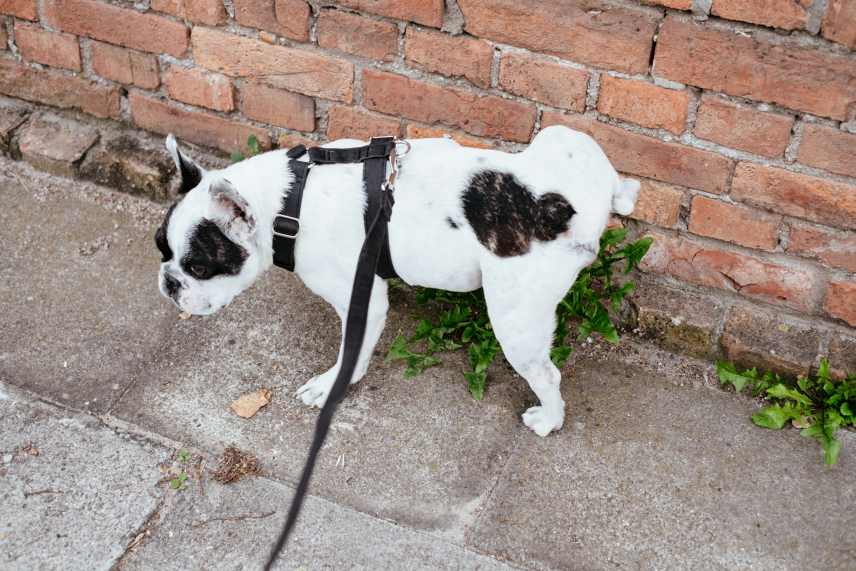Urinary tract infections (UTIs) are not uncommon in dogs and can cause discomfort and pain for our furry friends, therefore all dog owners should know what the symptoms of a dog with UTI look like. While both male and female dogs can develop UTIs, females are more prone to them due to their shorter urethra.
UTIs occur when bacteria enter the urinary tract and start to multiply, leading to inflammation and infection. If left untreated, UTIs can lead to more serious health problems, so it’s important to be aware of the symptoms of a dog with UTI.
One of the most common symptoms of a dog with UTI is frequent urination. Dogs with UTIs may need to go outside more often than usual and may have accidents in the house. They may also strain to urinate or only pass small amounts of urine. In some cases, dogs with UTIs may even cry out in pain while urinating. It’s important to note that these symptoms can also be caused by other health issues, so it’s important to consult with a veterinarian to determine the underlying cause.

Other symptoms of a dog with UTI may include blood in the urine, cloudy or strong-smelling urine, and excessive licking of the genital area. In some cases, dogs with UTIs may also experience fever, lethargy, and loss of appetite. If you notice any of these symptoms in your dog, it’s important to seek veterinary care as soon as possible to prevent the UTI from worsening and causing more serious health problems. By being aware of the symptoms of a dog with UTI, you can help ensure that your furry friend stays healthy and happy.
Understanding UTIs in Dogs
Defining Urinary Tract Infections
A urinary tract infection (UTI) is a common bacterial infection that affects dogs. It occurs when bacteria enter the urinary tract, which includes the bladder, urethra, and kidneys, and cause an infection. UTIs can cause discomfort and pain in dogs, and if left untreated, they can lead to serious health complications.
Causes of UTIs in Dogs
UTIs in dogs are typically caused by bacteria, such as Escherichia coli (E. coli), Proteus mirabilis, and Staphylococcus spp. These bacteria can enter the urinary tract through the urethra and travel up to the bladder and kidneys. Other factors that can contribute to the development of UTIs in dogs include a weakened immune system, bladder stones, and diabetes.
Risk Factors for Canine UTIs
Some dogs are more prone to developing UTIs than others. Female dogs are more likely to develop UTIs than males due to their shorter urethras. Dogs with diabetes or other diseases that weaken the immune system are also at a higher risk of developing UTIs. Additionally, dogs with bladder stones or other urinary tract abnormalities are more likely to develop UTIs.
Overall, understanding the causes and risk factors of UTIs in dogs is important for pet owners to help prevent and treat this common health issue. Regular veterinary check-ups and proper hygiene can also help reduce the risk of UTIs in dogs.

Identifying Symptoms of a Dog with UTI
UTIs are common in dogs and can be identified by a variety of symptoms. It’s important for pet owners to be aware of these symptoms so that they can seek veterinary care promptly to prevent complications.
Common Signs of UTIs
Dogs with UTIs may exhibit a range of behavioral changes and physical symptoms. Some common signs of UTIs include:
- Frequent urination
- Pain while urinating
- Straining to urinate
- Blood in the urine
- Cloudy urine
- Strong odor from urine
- Licking the genital area excessively
- Incontinence
Behavioral Changes
Dogs with UTIs may also exhibit behavioral changes such as:
- Increased irritability
- Loss of appetite
- Lethargy
- Restlessness
- Depression
Physical Symptoms
In addition to behavioral changes, dogs with UTIs may also exhibit physical symptoms such as:
- Fever
- Vomiting
- Abdominal pain
- Dehydration
If pet owners notice any of these symptoms, they should seek veterinary care immediately. UTIs can be treated with antibiotics, but if left untreated, they can lead to more serious health problems.
Diagnosing UTIs in Dogs
Veterinary Examination
When a dog presents with symptoms of a UTI, the first step is a thorough physical examination by a veterinarian. The vet will ask about the dog’s medical history and symptoms, and may perform a rectal exam to check for prostate enlargement or other abnormalities. The vet will also palpate the bladder to check for tenderness or distension.
Laboratory Tests
Urinalysis is an important diagnostic tool for UTIs in dogs. The vet will collect a urine sample and analyze it for the presence of bacteria, white blood cells, and other indicators of infection. A urine culture may also be performed to identify the specific bacteria causing the infection and determine the best course of treatment.
Imaging Techniques
In some cases, imaging techniques such as ultrasound or X-rays may be used to diagnose UTIs in dogs. Ultrasound can help identify abnormalities in the bladder or kidneys, while X-rays can detect bladder stones or other obstructions. However, these tests are not always necessary and may not be able to provide a definitive diagnosis on their own.
It is important to note that a culture and sensitivity test is the gold standard for diagnosing UTIs in dogs. This test can identify the specific bacteria causing the infection and determine which antibiotics will be most effective in treating it. Without a culture and sensitivity test, it is possible to misdiagnose a UTI and prescribe the wrong antibiotics, which can lead to antibiotic resistance and other complications.
Overall, a combination of veterinary examination, laboratory tests, and imaging techniques can help diagnose UTIs in dogs and determine the best course of treatment. It is important to work closely with a veterinarian to ensure proper diagnosis and treatment of UTIs in dogs.
Treating Canine UTIs
When a dog is diagnosed with a urinary tract infection (UTI), prompt treatment is necessary to prevent the infection from spreading and causing further complications. Treatment for canine UTIs typically involves a combination of antibiotics and supportive therapies.
Antibiotics and Medications
Antibiotics are the cornerstone of treatment for canine UTIs. The specific antibiotic prescribed will depend on the type of bacteria causing the infection and the severity of the infection. Commonly prescribed antibiotics include amoxicillin, cephalexin, and enrofloxacin.
In addition to antibiotics, pain medication may also be prescribed to help alleviate discomfort associated with the infection. It is important to follow the veterinarian’s instructions for administering antibiotics and pain medication to ensure the infection is properly treated.
Supportive Therapies
In addition to antibiotics and pain medication, supportive therapies may be recommended to help manage the infection and promote healing. These therapies may include:
- Increased water intake to help flush bacteria out of the urinary tract
- Probiotics to help restore beneficial bacteria in the gut
- Cranberry supplements to help prevent future UTIs
- A special diet to support urinary tract health
Surgical Interventions
In some cases, surgical intervention may be necessary to treat canine UTIs. This may be the case if the infection is caused by bladder stones or other urinary tract abnormalities. Surgery may also be necessary if the infection does not respond to antibiotics or if the dog is experiencing recurrent UTIs.
If antibiotics and supportive therapies are not effective in treating the UTI, the veterinarian may recommend surgical intervention. It is important to discuss the risks and benefits of surgery with the veterinarian before making a decision.
Overall, treatment for canine UTIs involves a combination of antibiotics, supportive therapies, and in some cases, surgical intervention. It is important to follow the veterinarian’s instructions for administering medication and to monitor the dog’s symptoms closely to ensure the infection is properly treated.
Preventing Recurrent UTIs
Dietary Adjustments
Dietary adjustments can play a crucial role in preventing recurrent UTIs in dogs. Feeding a high-quality, balanced diet can help maintain a healthy urinary tract. It is recommended to avoid feeding dogs with UTIs foods that are high in phosphorus and magnesium, which can contribute to the formation of urinary stones. Instead, opt for foods that are low in these minerals and high in moisture content.
Hydration and Urination
Proper hydration and regular urination are important in preventing recurrent UTIs. Encourage your dog to drink plenty of water and ensure that they have access to fresh water at all times. Taking your dog out for frequent potty breaks can also help prevent the buildup of bacteria in the urinary tract.
Regular Veterinary Check-Ups
Regular veterinary check-ups are crucial in preventing recurrent UTIs. During routine check-ups, your veterinarian can identify any underlying health issues that may contribute to UTIs and provide appropriate treatment. They can also monitor your dog’s urinary tract health and recommend dietary adjustments or supplements if necessary.
Overall, preventing recurrent UTIs in dogs requires a combination of dietary adjustments, proper hydration and urination, and regular veterinary check-ups. By following these simple steps, you can help keep your furry friend healthy and happy.
Special Considerations
UTIs in Male vs. Female Dogs
While both male and female dogs can develop UTIs, female dogs are more prone to this type of infection due to their shorter urethras. Male dogs, on the other hand, have a longer urethra that makes it more difficult for bacteria to travel up to the bladder. However, male dogs with prostate disease may be at a higher risk of developing UTIs.
Chronic Conditions and UTIs
Dogs with certain chronic conditions, such as Cushing’s disease, may be more susceptible to UTIs. Cushing’s disease can weaken the immune system and make it more difficult for the body to fight off infections. Additionally, dogs with bladder cancer may also be at a higher risk of developing UTIs.
Age-Related UTI Concerns
Older female dogs may be more prone to UTIs due to hormonal changes that occur during the aging process. As dogs age, their bodies produce less estrogen, which can lead to changes in the urinary tract that make it easier for bacteria to grow. It is important to monitor senior dogs for any signs of UTIs and seek veterinary care promptly if symptoms arise.
Conclusion: Symptoms of a Dog with UTI
In conclusion, it is important to be aware of the special considerations that may increase a dog’s risk of developing a UTI. By understanding these factors, pet owners can take steps to help prevent UTIs and seek prompt veterinary care if necessary.
3 Ways to Check the Temperature of a Dog

If you think your dog is suffering from a fever and want to check its temperature, you need a thermometer. Checking the temperature of a dog using a thermometer may sound like a very easy and routine exercise, but let me tell you, there are various things that you need to keep in mind to get an accurate reading while maintaining the safety of your lovely pet.
Continue reading: 3 Ways to Check the Temperature of a Dog
Do You Know What to Do If Your Dog Gets Sick And There is No Vet?

It’s a question most dog owners never think about, while others hope it never happens. But what if?
What if your dog gets sick and you are miles from the nearest vet?
What would you do?
Continue reading: What to Do If Your Dog Gets Sick And There is No Vet?
